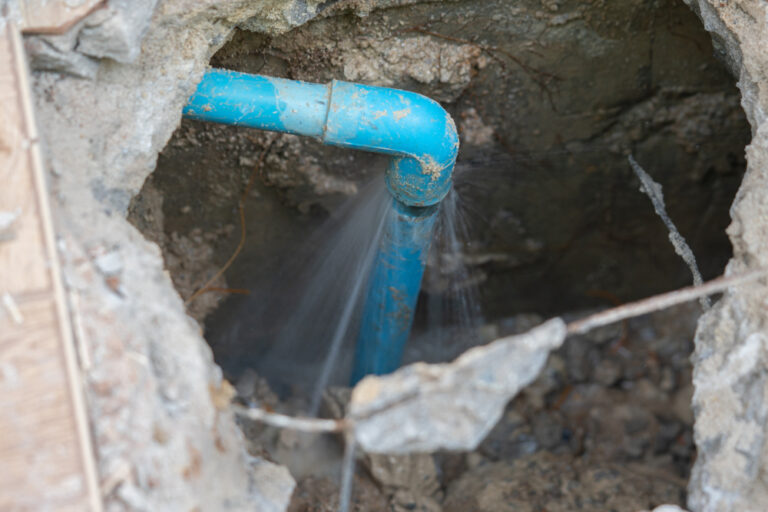Key Takeaways
- Underground water leaks can result in water waste, structural damage, and high repair costs.
- Indicators of leaks include unexplained high water bills, unusual puddles, mold growth, low water pressure, and strange noises.
- Routine inspections and appropriate maintenance can decrease the likelihood of leaks.
- Quick detection and repair are essential to minimize damage and improve sustainability.
Understanding the Threat of Underground Water Leaks
Underground water leaks can devastate households and buildings, causing significant water waste, structural damage, and high repair costs. It’s crucial to differentiate when to call a plumber vs water utility company to handle such issues effectively. The consequences of ignoring these leaks can escalate quickly, leading to severe damage. Water leaks, especially those that go undetected for long periods, can weaken the foundation of a building, erode soil, and even cause sinkholes. Therefore, awareness of the signs of an underground water leak is essential to mitigate potential hazards and preserve your property’s structural integrity.
Common Indicators of Underground Water Leaks
Unexplained Water Bills
One of the most noticeable signs of an underground water leak is an unexpected increase in your water bills. If your usage habits haven’t changed but your bill has skyrocketed, there might be a hidden leak. It’s pertinent for homeowners who have automated irrigation systems. Often, these systems can develop leaks underground, leading to a substantial increase in water bills without an apparent change in water usage habits.
Puddles and Damp Spots
Unusual puddles or consistently damp spots in your yard or basement indicate a leak. Promptly investigating these areas can prevent further damage. Pay attention to patches of grass that are greener or more lush than surrounding areas since these can indicate an underground water leak. In basements, unexplained damp spots or small pools of water on the floor may also indicate a hidden water leak.
Mold and Mildew Growth
Mold and mildew thrive in moist environments. If you notice such growth in unusual places, it could indicate moisture from an underground leak. Mold and mildew can lead to both structural damage and significant health hazards. The presence of mold often means a constant source of moisture, which can be traced back to an undetected water leak. Quickly dealing with any indications of mold or mildew is crucial for upholding a healthy living space.
Low Water Pressure
A sudden drop in water pressure might be due to water escaping from your pipes underground. This issue shouldn’t be ignored as it can indicate a significant leak. Consistent low water pressure across multiple fixtures in the house, such as faucets, showers, and toilets, can be a strong indicator of an underground leak. The loss of water through a leak reduces the overall water pressure in the system, making it difficult to carry out routine activities effectively.
Strange Noises
Sometimes, you may hear the sound of running water even when no taps are on. It could be a crucial sign indicating a leak somewhere underground. These noises are often described as hissing, whooshing, or gurgling sounds and are usually more noticeable during quiet times. If you hear such noises, especially at night, it’s essential to investigate further as they can indicate a significant water leak that needs immediate attention.
Steps to Confirm an Underground Water Leak
- Monitor Your Water Meter: Shut off all water outlets in your house and inspect the water meter. A movement in the meter reading indicates a possible leak. You can conduct this test by noting the reading on the water meter, ensuring no water is being used for a couple of hours, and then rechecking the meter. If the meter reading has altered without any water consumption, there is a probable leak in the system.
- Professional Inspection: Hiring an experienced plumber can provide a thorough inspection and confirmation. Experts utilize specialized tools like acoustic listening devices, ground microphones, and thermal imaging cameras to detect underground leaks accurately without causing unnecessary harm to your property. Their expertise and advanced tools ensure that the exact location of the leak is identified, enabling precise and effective repairs.
Preventive Measures
Regular Inspections
Consistent plumbing inspections are competent to detect possible problems early before they escalate into significant issues. Scheduling annual or bi-annual inspections with a professional plumber can help identify vulnerabilities in your plumbing system. During these inspections, professionals can spot early signs of wear and tear, corrosion, and leaks, preventing minor problems from escalating into costly repairs.
Proper Maintenance
Maintaining your plumbing system can extend its lifespan and reduce the likelihood of leaks. Regularly check and repair faulty pipes and fixtures. Simple maintenance tasks such as insulating exposed pipes, checking for corrosion, and ensuring all connections are secure can significantly reduce the risk of leaks.
Why Quick Detection Matters
Early detection and repair of underground leaks are vital. They prevent severe water damage, save on repair costs, and conserve water, contributing to broader efforts in sustainable water use. Moreover, quick action helps maintain the structural integrity of your property. Timely maintenance not only stops additional damage but also aids in preserving water resources, which is crucial amidst growing global water scarcity challenges. Staying proactive in detecting and addressing leaks protects your property and aligns with sustainable water management practices.
Additional Resources
For more detailed information on detecting and managing underground water leaks, visit this comprehensive guide. Knowledge is power; stay informed and proactive. Understanding the intricacies of your plumbing system and recognizing the early signs of leaks can save you from significant trouble and expense. Equip yourself with the correct information and resources to ensure the longevity and efficiency of your plumbing system.
